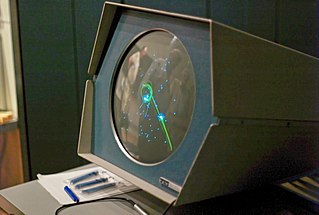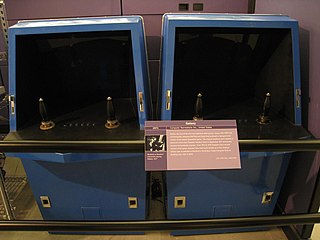See also
- The War in Space (1977 film) Japanese science-fiction film
- Interstellar war
Spacewar, Space Wars, or variation, may refer to:
Star Wars is an epic science fantasy saga created by George Lucas.

Computer Space is a space combat arcade game developed in 1971. Created by Nolan Bushnell and Ted Dabney in partnership as Syzygy Engineering, it was the first arcade video game as well as the first commercially available video game. Computer Space is a derivative of the 1962 computer game Spacewar!, possibly the first video game to spread to multiple computer installations. It features a rocket controlled by the player engaged in a missile battle with a pair of hardware-controlled flying saucers set against a starfield background. The goal is to score more hits than the enemy spaceships within a set time period, which awards a free round of gameplay. The game is enclosed in a custom fiberglass cabinet, which Bushnell designed to look futuristic.
A single-player video game is a video game where input from only one player is expected throughout the course of the gaming session. A single-player game is usually a game that can only be played by one person, while "single-player mode" is usually a game mode designed to be played by a single player, though the game also contains multi-player modes.
Shooter video games or shooters are a subgenre of action video games where the focus is almost entirely on the defeat of the character's enemies using the weapons given to the player. Usually these weapons are firearms or some other long-range weapons, and can be used in combination with other tools such as grenades for indirect offense, armor for additional defense, or accessories such as telescopic sights to modify the behavior of the weapons. A common resource found in many shooter games is ammunition, armor or health, or upgrades which augment the player character's weapons.

Star Trek is a text-based strategy video game based on the Star Trek television series and originally released in 1971. In the game, the player commands the USS Enterprise on a mission to hunt down and destroy an invading fleet of Klingon warships. The player travels through the 64 quadrants of the galaxy to attack enemy ships with phasers and photon torpedoes in turn-based battles and refuel at starbases in order to eliminate all enemies before running out of time.
A slug is a gastropod mollusk without a shell or with a very small internal shell.
Avatar is a term used in Hinduism for a material manifestation of a deity. Other common uses include:

Cinematronics Incorporated was an arcade game developer that primarily released vector graphics games in the late 1970s and early 1980s. While other companies released games based on raster displays, early in their history, Cinematronics and Atari, Inc. released vector-display games, which offered a distinctive look and a greater graphic capability, at the cost of being only black and white (initially). Cinematronics also published Dragon's Lair in 1983, the first major LaserDisc video game.

Space Wars is a shooter video game released in arcades by Cinematronics in 1977. Like the PDP-1 program Spacewar! (1962) it is based on, it uses black and white vector graphics for the visuals. The hardware developed for Space Wars became the platform for most of the vector-based arcade games from Cinematronics. It was distributed in Japan by Taito in 1978, and a Vectrex port was published in 1982.

Space War is a video game cartridge released by Atari, Inc. in 1978 for the Atari Video Computer System. The game is a version of Spacewar!, the 1962 computer game by Steve Russell. It was released by Sears as Space Combat, for its Atari compatible Tele-Games system. An Atari Lynx update was planned but never released.

The RCA Studio II is a home video game console made by RCA that debuted in January 1977. The graphics of Studio II games were black and white and resembled those of earlier Pong consoles and their clones. The Studio II also did not have joysticks or similar game controllers but instead used two ten-button keypads that were built into the console itself. The console was capable of making simple beep sounds with slight variations in tone and length. The Studio II included five built-in games.

Spacewar! is a space combat video game developed in 1962 by Steve Russell in collaboration with Martin Graetz, Wayne Wiitanen, Bob Saunders, Steve Piner, and others. It was written for the newly installed DEC PDP-1 minicomputer at the Massachusetts Institute of Technology. After its initial creation, Spacewar! was expanded further by other students and employees of universities in the area, including Dan Edwards and Peter Samson. It was also spread to many of the few dozen installations of the PDP-1 computer, making Spacewar! the first known video game to be played at multiple computer installations.
Wraparound, in video games, is a gameplay variation on the single-screen in which space is finite but unbounded; objects leaving one side of the screen immediately reappear on the opposite side, maintaining speed and trajectory. This is referred to as "wraparound", since the top and bottom of the screen wrap around to meet, as do the left and right sides. Some games wrap around in some directions but not others, such as games of the Civilization series that wrap around left to right, or east and west but the top and bottom remain edges representing the North and South Pole.

Galaxy Game is a space combat arcade game developed in 1971 during the early era of video games. Created by Bill Pitts and Hugh Tuck, it was one of the first coin-operated video games; its initial prototype display in November 1971 at the Tresidder student union building at Stanford University was only a few months after a similar display of a prototype of Computer Space, making it the second known video game to charge money to play. Galaxy Game is an expanded version of the 1962 Spacewar!, potentially the first video game to spread to multiple computer installations. It features two spaceships, "the needle" and "the wedge", engaged in a dogfight while maneuvering in the gravity well of a star. Both ships are controlled by human players.
The history of video games spans a period of time between the invention of the first electronic games and today, covering many inventions and developments. Video gaming reached mainstream popularity in the 1970s and 1980s, when arcade video games, gaming consoles and home computer games were introduced to the general public. Since then, video gaming has become a popular form of entertainment and a part of modern culture in most parts of the world. The early history of video games, therefore, covers the period of time between the first interactive electronic game with an electronic display in 1947, the first true video games in the early 1950s, and the rise of early arcade video games in the 1970s. During this time there was a wide range of devices and inventions corresponding with large advances in computing technology, and the actual first video game is dependent on the definition of "video game" used.
Ascent or The Ascent may refer to:
Third-person shooter (TPS) is a subgenre of 3D shooter games in which the gameplay consists primarily of shooting. It is closely related to first-person shooters, but with the player character visible on-screen during play. While 2D shoot 'em up games also employ a third-person perspective, the TPS genre is distinguished by having the game presented with the player's avatar as a primary focus of the camera's view.
Bouncer(s) or The Bouncer may refer to:
Trek-80 is a text-based video game written by Steve Dompier in 1976 and sold by Processor Technology for their Sol-20 computer and suitable S-100 bus machines.